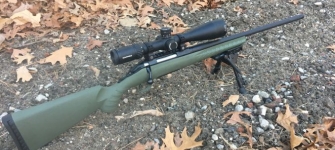Ruger American Rifle Predator 6

Build details
In this post, I take a look at the Ruger American Rifle.
The Ruger American Rifle was introduced in 2011. I’ve owned a few Ruger M77s over the years, but never spent anytime behind the trigger of an American. A quick trip to my local dealer and I was the proud owner of a Ruger American Rifle Predator in 6 Creedmoor Model 16948.
The Predator variant of the American Rifle line has a heavier barrel, green furniture and threaded muzzle. My test rifle is chambered in 6 Creedmoor, a cartridge I’ve been shooting for years but is just emerging on the factory rifle scene. This batch of Rugers is the first generation of factory rifles available with a 6 Creedmoor chamber. Kudos to Ruger for staying innovative. The American Rifle is also available in 223 Remington, 243 Winchester, 6,5 Creedmoor, 270 Winchester, 7mm-08 Remington, 308 Winchester, 30-06 Springfield
The test rifle cost me $400 plus tax. At the time of writing (3/2017), this seems to be a fairly middle of the road price. It is more expensive than a Savage Axis but costs less than a Tikka T3/T3X, Remington 700 SPS or Savage 10.
Let’s start by examining the injection molded plastic stock. The predator has a green stock, while the rest of the American Rifle line has one in black. Note the entire fore end is supported by a series of molded plastic gussets.
Some of the edges, like the end of the barrel channel (above), are rough with casting marks.
The action is mated to the stock with Ruger’s Power Bedding system. This system uses two metal V-blocks, fore and aft of the magazine well. Each block has a hole to allow an action screw to pass through and mates to a recess in the bottom of the receiver.
When you flip over the barreled action, you’ll notice the contact areas for the Power Bedding system. In addition to providing metal bedding pillars, they also act as dual recoil lugs. Note there is no recoil lug forward of the receiver face. I was pretty impressed with the ingenuity of the system. The Tikka T3/T3x and Savage Axis both use a floating recoil lug, however, it is a single contact point located forward of the action screws.
The 22″ hammer forged 1:7.7″ twist barrel is head spaced in the receiver with a barrel nut assembly (above, front edge of receiver). A 5/8-24 thread which is protected by a thread protector is provided for attachment of muzzle devices
The trigger guard of the American is molded into the stock as one piece. This works, but lacks soul.
A polymer 4-shot rotary magazine feeds the American. Despite Ruger’s claim of the magazine holding 4 rounds, I wasn’t able to fit more than 3 in mine. The magazine fed flawlessly during my testing and evaluation, however, I have read some reviews critical of it. The magazine allowed cartridges up to 2.850″ in length.
The magazine is retained by small flexible plastic tab on its front. This tab retains the magazine in the stock and serves as the release. This system effectively negates the need for “bottom metal” since the magazine just snaps into the molded plastic stock.
 The Ruger American uses a one-piece, 3-lug, bolt design that provides the shooter with a 70 degree throw. Bolt lift is great and the action cycles surprisingly well. The side of the bolt has a groove that serves as a bolt guide by allowing the bolt removal lever to slide inside of it (below).
The Ruger American uses a one-piece, 3-lug, bolt design that provides the shooter with a 70 degree throw. Bolt lift is great and the action cycles surprisingly well. The side of the bolt has a groove that serves as a bolt guide by allowing the bolt removal lever to slide inside of it (below).
The bolt removal lever (above), is held in place by a blind pin. By guiding the bolt with the take down lever, Ruger doesn’t need to broach raceways for a bolt head, keeping production costs down. Clever. I could do without the blind pin, but the system did work.
A front view of the Ruger American Rifle’s bolt face. The rifle uses a sliding extractor and constant tension ejector. Unfortunately the bolt shroud is plastic. Ruger, take note Tikka did this on the T3, but later upgraded to metal on the T3X.
The American is equipped with the Marksman Adjustable Trigger. Ruger claims it can be user adjusted from 3-5 pounds using a small screw on the front of the assembly. From the factory, the trigger had an average pull of 4 pounds 10.5 ounces over 5 pulls. The lightest I was able to adjust the trigger was 4 pounds 4.4 ounces, requiring complete removal of the adjustment screw. The barreled action needs to be removed from the stock to adjust the trigger.
The Marksman Adjustable trigger was decent. Far better than a Savage AXIS or Remington 700, similar to a Savage Accutrigger, but not as nice as a Tikka T3.
A two-position tang-mounted safety is easily accessible and reminiscent of the Browning A-Bolt series of rifles. The safety allows the bolt to be manipulated while it is engaged.
Ruger includes a factory installed Weaver style scope rail. While they did do a nice job finishing it, the spacing of the rails was not to Picatinny standards. This means if you are using a one piece mount that was designed to work with a Picatinny rail, you may encounter issues. I would guess most users are running separate rings, so this would not be a problem. The rail attachment screws were tight from the factory (Mossberg: call your office).
For testing and evaluation purposes I equipped the rifle with a Nightforce SHV 4-14x50mm F1 scope, Nightforce rings and a Harris bipod. I realize the scope costs more than twice as much as the rifle, however I’ve found that using a substandard optic can introduce additional variables into the testing and evaluation process. By sticking with a high quality scope and ring set up, I am able to ensure the rifle’s performance is in fact based on the rifle’s merit alone. For this reason, you’ll see Nightforce and TRACT Optics scopes for the vast majority of testing on this site.
I used a mix of handloads and custom factory ammunition to test the Ruger American Rifle. The factory load is the 105 gr BTHP from Copper Creek Cartridge Company (C4) ammunition (above). Copper Creek is a custom ammunition company that makes a great product and is worth a look, especially if you don’t reload.
WARNING: The loads shown are for informational purposes only. They are only safe in the rifle shown and may not be safe in yours. Consult appropriate load manuals prior to developing your own handloads. Rifleshooter.com and its authors, do not assume any responsibility, directly or indirectly for the safety of the readers attempting to follow any instructions or perform any of the tasks shown, or the use or misuse of any information contained herein, on this website.
My handloads were Sierra 107 gr. and 110 gr. MatchKing (SMK) over H4350 powder, Wolf primers and Hornady brass. OAL for the 107 SMK loads was 2.750″. OAL for the 110 SMK loads was 2.850″.
Target distance was 100 yards and all shooting was conducted prone, from a bipod with a rear bag. I used a MagnetoSpeed barrel mounted ballistic chronograph to gather data.
Results are below:
Group size ranged from .981″ (.937 MOA) to 1.568″ (1.498″) with an average of 1.233″ (1.178 MOA).
Most of these 5 shot groups started out as tight 3 shot groups with the fourth or fifth round opening them up. Take a look at the target above and note that all of the groups show a flyer. In my experience, this indicates the rifle would perform better in a better quality stock.
So, what are my final thoughts of the Ruger American Rifle?
- America! It’s a rifle that’s made-in-America by Americans and called the American. Wow! That is a lot of win! I’m shocked that a bald eagle didn’t swoop down and steal it from the firing line!
- Lots of innovation! I like the 3 -lug, short bolt-throw, 6 Creedmoor chamber, dual v-block bedding system and 1:7.7″ twist on this rifle.
- Accurate enough. Despite the shortcomings of the stock, the rifle did average 1.178 MOA across seven different five shot groups. The 110 SMK load went below 1 MOA. For $400 this is pretty decent. Further load development would likely improve these results.
- Trigger is OK. The Marksman Trigger worked well and was nice for a rifle in this price range. I don’t understand why Ruger would specify an adjustment range that was as specific as they advertise and then ship rifles that won’t adjust to it. Seems like the marketing department beat up the engineering department at a meeting.
- Mixed bag. With this rifle you have a mix of some really nice features like the 3-lug bolt, external bolt release, and decent scope rail with a cheap looking stock. While I admire the innovation of the stock and magazine system that completely does away with parts like bottom metal and a separate trigger guard to save money, it doesn’t match the quality or thoughtfulness of the barreled action.
- Needs a better home. I think the metal parts of this rifle are far better than the plastic stock and magazine. Modular Driven Technologies (MDT) makes an LSS chassis system for the American Rifle. I have one on order. &n































build comments